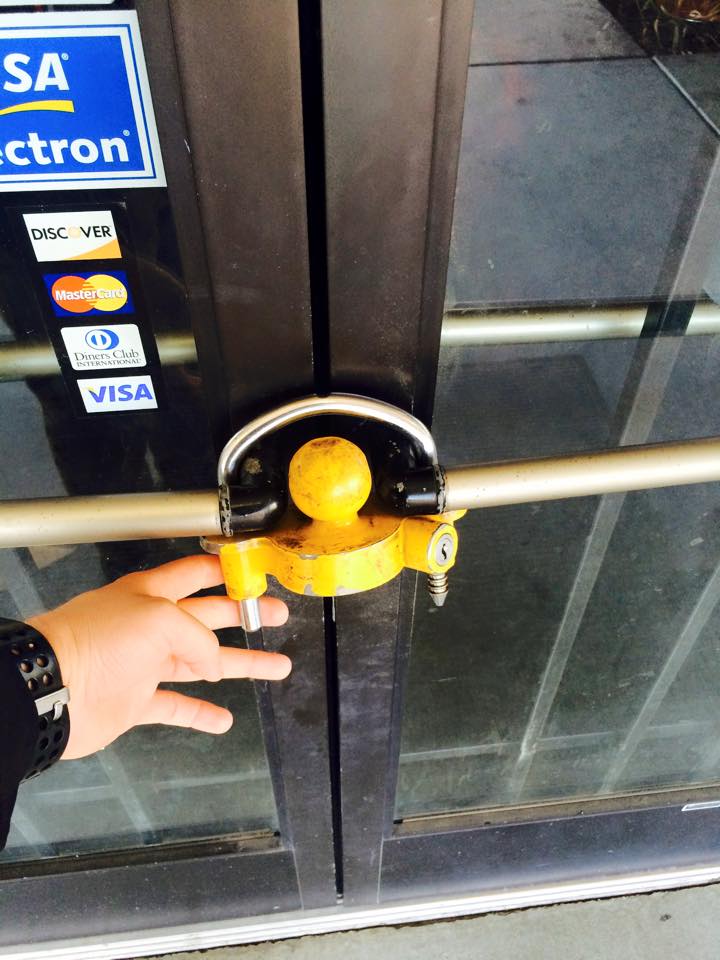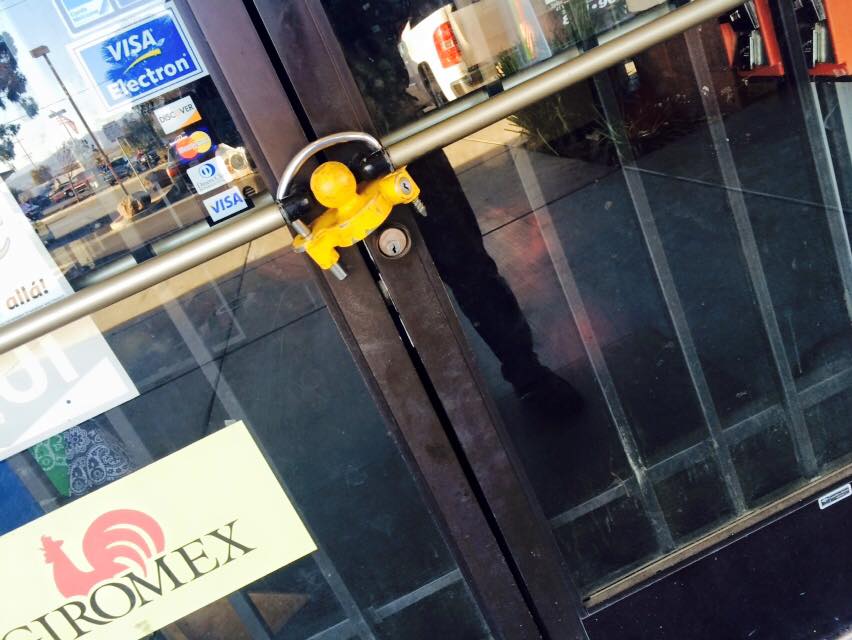This Wordless Wednesday photo illustrates what happens when the original locking hardware no longer works and someone is looking for a cheaper solution than repairing or replacing it. The IBC allows key-operated locks in some locations – do you think this lock is compliant with the language below if the required signage is included? And for extra credit, who knows what kind of lock this is? 🙂
1010.1.9.3 (2) In buildings in occupancy Group A having an occupant load of 300 or less, Groups B, F, M and S, and in places of religious worship, the main door or doors are permitted to be equipped with key-operated locking devices from the egress side provided:
2.1. The locking device is readily distinguishable as locked.
2.2. A readily visible durable sign is posted on the egress side on or adjacent to the door stating: THIS DOOR TO REMAIN UNLOCKED WHEN THIS SPACE IS OCCUPIED. The sign shall be in letters 1 inch (25 mm) high on a contrasting background.
2.3. The use of the key-operated locking device is revokable by the building official for due cause.
These were posted on the Truck Floor Training Facebook page by Jhonnatan Morales, and are re-posted here with his permission.
You need to login or register to bookmark/favorite this content.







I’m going to say no. “…are permitted to be equipped with key-operated locking devices FROM THE EGRESS SIDE…”
Extra credit: It’s a trailer hitch lock, to keep someone from towing your trailer away.
Firstly, you are getting a bit wordy for WW.
Secondly, I think the lock itself is a trailer ball hitch to prevent attachment by some other vehicle. In other words, it locks onto the trailer side.
When I just post a photo sometimes people ask for more info, so this is my very own modified version of Wordless Wednesday. 🙂 The other day I read an email where someone was recommending my website to a colleague, and she said, “sometimes it’s a little light on detail…” On the other hand, when I posted one of my articles someone said it was too long! As John Lydgate said, “You can please some of the people all of the time, you can please all of the people some of the time, but you can’t please all of the people all of the time.”
Lori,
As long as you please yourself. I love what you say or don’t say; it’s always fun.
If the place is not occupied yes, not much different from a security gate or overhead door
It definitely doesn’t look like it is on the egress side. Also, I see lots of signs but not one related to the door being unlocked when the building is occupied but it may be on the egress side.
Unfortunately, we have no Convention, but we still have Lori and this wonderful forum.
Anyway… the lock is definitely on the exterior (you can see cars in the reflection and all the stickers read correctly) so this would be a violation of the “from the egress side” requirement, “if” the building was occupied. It doesn’t appear to be and if the deadlock worked, there would be no need for the trailer hitch lock. In this case, a simple padlock would have sufficed.
For the “younger than the old goat” generation, BEST used to offer a massive “king pin” lock for trailers. Not sure if they still offer this.
Thanks Jerry! 🙂
This lock is not legal if the building is occupied because it is not operable from the inside. It does satisfy the requirement of one lock unlocking both doors (provided the inactive leaf does not have flushbolts), but it fails to meet the criteria of “…one “obvious” means of locking/unlocking the door” as there are two things which would confuse the user could about which one to unlock for egress.
Replacing or re-keying the cylinder(s) is less expensive than the hitch lock and still satisfies the utmost concern for the building occupants, that the door is unlocked by one means and that it not be locked when the building is occupied. Model building codes are not onerous, they establish minimum criteria necessary to safeguard the occupant of the building. This is an example of “going the long way ’round the barn” and still not meeting the minimum requirements for the safety of the occupants.
As long as this hideous device is employed only when the building is vacant, yes, it’s legal.
I see variations of this more than you can imagine.
Owners/renters don’t want to pay to have their storefront hardware replaced or repaired.
I’ve seen chains, bike locks, bent rebar.
The REAL problem is that come in the store in the morning to do paperwork or get ready for the day and they put those bogus locks on the “inside” of the doors, effectively locking themselves in illegally.
I would not change anything, good job.
I have seen exteriors doors barricaded like this and worse. Not knowing the full story here it could be that these doors no longer function as an exit due to renovation inside the store space . I have even seen exit doors shut and sealed with silicone caulk .